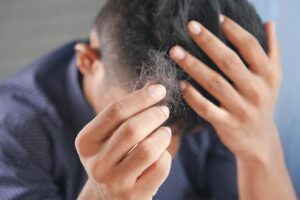 In the past I’ve written about Platelet Rich Plasma (PRP) as a treatment for men and women who want to reverse or prevent further natural hair loss at early or advanced stages, and also as a way to bolster the results of hair transplants. My blogs explained the procedure we perform at New Jersey Pain Care Specialists and the reasons why it it safe and effective.
In the past I’ve written about Platelet Rich Plasma (PRP) as a treatment for men and women who want to reverse or prevent further natural hair loss at early or advanced stages, and also as a way to bolster the results of hair transplants. My blogs explained the procedure we perform at New Jersey Pain Care Specialists and the reasons why it it safe and effective.
Today, I’m adding a scientific report from the U.S. National Library of Medicine at the National Institutes of Health to support the kind of terrific results our patients have enjoyed. If you’ve had any doubts about PRP Therapy for treating your own hair loss, these government studies will give you the confidence to get the healthy hair you’ve been dreaming about.
Study Intro
Androgenic alopecia (known as male pattern baldness) is a very common type of hair loss observed in both males and females. Platelet-rich plasma (PRP) is a preparation of platelets in concentrated plasma. It is hypothesised that growth factors released from platelets may act on stem cells in the bulge area of the follicles, stimulating the development of new follicles and promoting the formation of new blood vessels. The aim our pilot study was to evaluate the safety, efficacy and feasibility of PRP Therapy for treatment of androgenic alopecia.
Method
Between August 2013 and November 2013, patients suffering from androgenic alopecia and who were on topical hair treaments minoxidil and finasteride for at least 6 months without much improvement were considered for PRP therapy.
A hair pull test was performed before every treatment session and photos were taken. PRP was created from the patient’s own blood and injected in the scalp by using multiple small injections. The treatment was repeated every two weeks, for a total of four times. The outcome was assessed after 3 months by clinical examination, macroscopic photos, hair pull test and patient’s overall satisfaction.
Results
A significant reduction in hair loss was observed between first and fourth injection.
Conclusion
PRP Therapy for androgenic alopecia is a simple, cost-effective and feasible treatment option for hair loss and can be regarded as a valuable adjuvant treatment modality for androgenic alopecia. Although PRP has sufficient theoretical scientific basis to support its use in hair restoration, hair restoration using PRP is still at its infancy. Clinical evidence is still weak. Considering its excellent safety profile and relatively low cost, PRP hair treatment is a promising treatment option for patients with thinning hair.71 hair follicular units to 93 hair follicular units — an average gain of 22.09 follicular units..After the fourth session, the pull test was negative in over 80% of patients.
Can PRP Therapy help to stem or reverse your hair loss, or improve your hair transplant results? A consultation with NJ Pain Care Specialists can help you decide.
At the present time, PRP Treatments are not covered by medical insurance.
